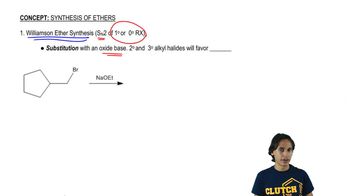Here are the essential concepts you must grasp in order to answer the question correctly.
Oxymercuration–Reduction
Oxymercuration–reduction is a two-step reaction used to convert alkenes into alcohols or ethers without carbocation rearrangement. The first step involves the addition of mercuric acetate to the alkene, forming a mercurinium ion intermediate. In the second step, sodium borohydride (NaBH4) reduces the intermediate, replacing the mercury with a hydrogen atom, resulting in the formation of an alcohol or ether.
Recommended video:
General properties of oxymercuration-reduction.
Alkene Selection
Choosing the correct alkene is crucial for synthesizing the desired ether. The alkene's structure determines the position where the ether linkage will form. Typically, the alkene should have a double bond at the location where the ether's oxygen will be introduced, ensuring the correct regioselectivity and stereochemistry in the final product.
Recommended video:
Alkene Metathesis Concept 1
Reaction Conditions for Ether Synthesis
To synthesize ethers using oxymercuration–reduction, the reaction conditions must be carefully controlled. The process involves using an alcohol as a nucleophile instead of water in the oxymercuration step. This modification allows the formation of an ether linkage instead of an alcohol, with the alcohol's oxygen attacking the mercurinium ion, leading to the desired ether product after reduction.
Recommended video:
The Mechanism of Williamson Ether Synthesis.

 Verified step by step guidance
Verified step by step guidance Verified video answer for a similar problem:
Verified video answer for a similar problem:



 4:21m
4:21m